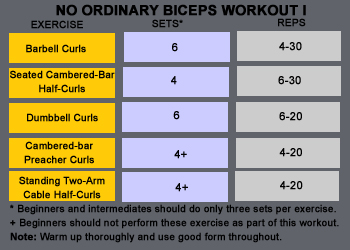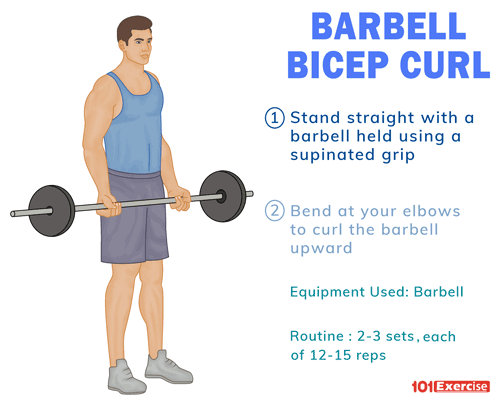Have you ever wondered how many reps and sets you should do for barbell curls? It’s a question that many people ask when they are trying to build stronger and bigger biceps. Well, the answer isn’t as simple as a one-size-fits-all approach. The number of reps and sets you should do for barbell curls depends on your individual goals and fitness level. In this article, we will discuss the factors to consider and provide you with some guidelines to help you determine the ideal number of reps and sets for your barbell curls.
First and foremost, it’s important to understand that the number of reps and sets you perform during your barbell curls will determine the outcome of your workout. If your goal is to increase muscle strength and power, then you should focus on performing fewer reps with heavier weights.
On the other hand, if your goal is to build muscle size and endurance, then you should aim for higher reps with lighter weights. The general guideline for strength training is to perform 1 to 6 reps of barbell curls for 3 to 6 sets, while for muscle hypertrophy, aim for 8 to 12 reps for 3 to 6 sets. However, it’s essential to listen to your body and adjust the number of reps and sets according to your own level of comfort and progress.
In the next paragraphs, we will explore the benefits of different rep ranges and provide more specific recommendations based on your fitness goals. So, keep reading to learn more about how to optimize your barbell curl workouts and achieve the results you desire!

Understanding Barbell Curls
Barbell curls are a popular exercise that primarily targets the biceps muscles. It involves lifting a barbell using a supinated grip, with your palms facing upward. This exercise is commonly performed in the gym and is considered a staple in any upper body strength training routine.
Benefits of Barbell Curls
Barbell curls offer numerous benefits for individuals looking to improve their strength, muscle size, endurance, and overall arm aesthetics. Here are some key benefits of incorporating barbell curls into your workout routine:
- Improved arm strength: Barbell curls primarily target the biceps, which play a crucial role in various upper body movements. Regularly performing barbell curls can help increase your arm strength, allowing you to perform daily activities with ease.
- Increased muscle size: Barbell curls are an effective exercise for muscle hypertrophy (muscle growth) in the biceps. When performed regularly with proper form and proper weight, they can help increase the size and definition of your biceps muscles.
- Functional upper body strength: The biceps muscles are involved in many daily tasks, such as lifting objects and pulling movements. By strengthening your biceps through barbell curls, you can enhance your overall upper body strength and perform these tasks more efficiently.
- Improved aesthetics: One of the main reasons people include barbell curls in their workout routine is to develop well-defined biceps muscles. Barbell curls can help sculpt and shape your biceps, leading to a more aesthetically pleasing appearance.
Importance of Proper Form
To maximize the benefits of barbell curls and avoid injuries, it is crucial to use proper form during the exercise. Here are some key points to keep in mind:
- Grip the barbell with your hands slightly wider than shoulder-width apart, with your palms facing up.
- Keep your elbows close to your body and avoid using excessive momentum to lift the weight.
- Begin the movement with your arms fully extended, and slowly curl the barbell up towards your shoulders.
- Squeeze your biceps at the top of the movement before slowly lowering the weight back down to the starting position.
Using improper form, such as using excessive momentum or swinging the weight, can lead to injuries and reduce the effectiveness of the exercise. It is recommended to consult with a fitness professional or watch instructional videos to ensure proper form.
Determining Reps and Sets for Barbell Curls
When it comes to determining the number of reps (repetitions) and sets for barbell curls, several factors need to be considered. These factors include your personal fitness goals, experience level, and the specific muscle group you want to target.
Factors to Consider
- Personal Fitness Goals: Your fitness goals will heavily influence the number of reps and sets you should perform. For example, if your goal is primarily strength gain, you may perform lower reps with higher weight. On the other hand, if your goal is muscle hypertrophy or endurance, higher reps with moderate weight may be more appropriate.
- Experience Level: Beginners may start with a lower number of reps and sets to allow their muscles and joints to adapt to the exercise. As you gain experience and strength, you can gradually increase the reps and sets.
- Muscle Group Targeting: Barbell curls primarily target the biceps muscles. However, depending on your goals, you may want to incorporate other exercises that target different muscle groups, such as the forearms or upper back. The number of reps and sets for barbell curls may be adjusted accordingly.
Personal Fitness Goals
The number of reps and sets you perform should align with your personal fitness goals. Here are some general guidelines for different fitness goals:
- Strength Gain: To focus on strength gain, aim for lower reps (around 4-8 reps per set) with heavier weights. This will stimulate your muscles to increase their strength.
- Muscle Hypertrophy: If your goal is to increase muscle size, performing moderate to high reps (around 8-12 reps per set) with a weight that challenges your muscles is recommended. This range is often considered optimal for muscle hypertrophy.
- Endurance and Toning: For endurance and toning, higher reps (around 12-15 reps per set) with lighter weights can be effective. This helps increase muscular endurance and improve muscle definition.
Determining the Appropriate Weight
Choosing the appropriate weight for barbell curls depends on your fitness level and the number of reps and sets you are performing. Here are some guidelines:
- Beginners: Start with a weight that allows you to complete the desired number of reps and sets with proper form. It should be challenging but manageable, and you should not sacrifice form for heavier weights.
- Intermediate and Advanced Lifters: As you advance in strength and experience, gradually increase the weight to continue challenging your muscles. The weight should be heavy enough to make the last few reps of each set challenging but still achievable with proper form.
Progression and Overload
To continue making progress with barbell curls, it is essential to incorporate the principles of progression and overload. This means gradually increasing the weights, reps, or sets over time to continually challenge your muscles and stimulate further adaptations. Progressing too quickly can increase the risk of injuries, so it is important to listen to your body and progress at a comfortable pace.
Strength and Muscle Building
The number of reps and sets you perform for barbell curls can significantly impact your strength and muscle-building goals. Here are some key considerations:
Rep Range for Strength Gain
To focus on strength gain, lower reps (around 4-8 reps per set) are commonly recommended. This rep range allows you to lift heavier weights, which stimulates the nervous system and increases muscular strength. By challenging your muscles with heavier weights, you can gradually increase your strength over time.
Rep Range for Muscle Hypertrophy
For individuals looking to increase muscle size, moderate to high reps (around 8-12 reps per set) are generally recommended. This rep range has been shown to induce hypertrophy by stimulating the muscles to grow. By performing a higher number of reps, you increase the time under tension, which is crucial for muscle growth.
Training Frequency
The frequency at which you perform barbell curls also plays a role in strength and muscle building. It is generally recommended to allow adequate rest and recovery between workout sessions targeting the same muscle group. This allows your muscles to repair and grow. For most individuals, training the biceps muscles 2-3 times per week is sufficient for optimal results.
Endurance and Toning
If your goal is to improve endurance or tone your muscles, the number of reps and sets for barbell curls will differ slightly. Here are some guidelines:
Rep Range for Endurance
To improve muscular endurance, higher reps (around 12-15 reps per set) with lighter weights are recommended. This rep range challenges your muscles to sustain activity for a longer duration, promoting improved endurance.
Rep Range for Toning
When it comes to toning and increasing muscle definition, a combination of moderate to high reps (around 8-12 reps per set) and proper nutrition is key. Toning involves reducing body fat while maintaining or increasing muscle mass. By incorporating barbell curls with other exercises and maintaining a slight calorie deficit, you can achieve a toned appearance.
Incorporating Supersets and Circuits
To further challenge your muscles and increase the intensity of your workout, you can incorporate supersets or circuits. Supersets involve performing two exercises back to back with minimal rest in between, while circuits involve performing multiple exercises in succession. These techniques can help increase the total volume of your workout and improve muscular endurance.

Injury Prevention and Rehabilitation
Properly managing the number of reps and sets for barbell curls is crucial for injury prevention and rehabilitation. Here are some important considerations:
Modifying Rep and Set Ranges
If you are recovering from an injury or have specific limitations, it may be necessary to modify the number of reps and sets for barbell curls. It is recommended to consult with a healthcare professional or a qualified fitness trainer who can guide you through the appropriate modifications based on your specific needs.
Recovery and Rest Periods
Allowing adequate rest and recovery between sets and workouts is essential for preventing injuries and optimizing muscle growth. Rest periods between sets can vary depending on your fitness goals and personal preference. However, a general guideline is to rest for 1-2 minutes between sets to allow for partial recovery.
Avoiding Overtraining
Overtraining occurs when you consistently push your body beyond its capacity to recover. This can lead to muscle fatigue, decreased performance, and an increased risk of injuries. It is important to listen to your body and give yourself enough rest between workouts to avoid overtraining. Adequate sleep, proper nutrition, and managing stress levels are also crucial factors.
Varying Reps and Sets
To prevent training plateaus and keep your workouts exciting, it is beneficial to vary the number of reps and sets for barbell curls. Here are some strategies to consider:
Plateau Prevention
As your muscles adapt to a specific rep and set scheme, they may reach a plateau where they are no longer challenged. To overcome plateaus, you can introduce variations in the number of reps and sets. This can include performing different rep ranges or incorporating different training techniques, such as drop sets or tempo variations.
Periodization
Periodization involves organizing your training into distinct phases, each with its own specific goals and rep and set schemes. By incorporating periodization into your workout routine, you can optimize your progress and continue making gains. This approach allows you to focus on different training aspects, such as strength, power, endurance, and hypertrophy, throughout the training cycle.
Integrating Different Rep and Set Schemes
Experimenting with different rep and set schemes can help keep your workouts engaging and challenging. For example, you can perform pyramid sets (increasing or decreasing weight with each set) or reverse pyramid sets (decreasing or increasing weight with each set). You can also incorporate drop sets, where you perform a set to failure, then immediately reduce the weight and perform another set.

Individualizing Reps and Sets
Every individual is unique, and what works for one person may not work for another. It is important to listen to your body, adapt based on feedback, and work with a fitness professional when necessary. Here are some key points to consider:
Listening to Your Body
Pay attention to how your body responds to different rep and set schemes. If a particular scheme consistently leads to excessive muscle soreness, fatigue, or joint discomfort, it may indicate that it is not suitable for you. Conversely, if a certain scheme consistently allows you to progress and recover adequately, it may be a good fit.
Adapting Based on Feedback
Continually assessing your progress and making adjustments based on your feedback is crucial for long-term success. Monitor your strength gains, muscle size changes, and overall workout performance. If you are not seeing the desired results, consider adjusting your rep and set schemes, as well as other training variables such as weight, rest periods, or exercise selection.
Working with a Fitness Professional
If you are unsure about determining the appropriate number of reps and sets for barbell curls, working with a fitness professional can provide valuable guidance. They can assess your goals, experience level, and overall fitness needs to tailor a workout plan specifically for you. They can also monitor your progress and make necessary adjustments to ensure you are on the right track.
Tracking Progress
To effectively gauge your progress and make informed adjustments to your rep and set schemes, it is beneficial to keep a workout log and measure your physical improvements. Here are some key points to consider:
Keeping a Workout Log
A workout log allows you to record the details of your workouts, including the number of reps, sets, weights used, and any pertinent notes about your performance. It can serve as a valuable reference to track your progress, identify patterns, and make data-driven decisions when it comes to adjusting your rep and set schemes.
Measuring Strength and Muscle Gains
Regularly assessing your strength and muscle gains can help you determine whether your current rep and set schemes are effective. This can be done through measuring the weight you can lift for a certain number of reps or through more visual indicators, such as progress photos or body measurements.
Reevaluating Reps and Sets
It is important to periodically reevaluate your reps and sets to ensure you are continuously making progress. As you become stronger and more experienced, you may need to adjust your rep and set schemes to keep challenging your muscles and stimulating further growth. Regularly reassessing your goals and consulting with a fitness professional can help you make informed decisions.

Conclusion
Determining the appropriate number of reps and sets for barbell curls is not a one-size-fits-all approach. It should align with your personal fitness goals, experience level, and the specific muscle groups you want to target. It is crucial to use proper form, progressively overload your muscles, and listen to your body’s feedback.
By individualizing your rep and set schemes, tracking your progress, and making necessary adjustments, you can optimize the effectiveness of your barbell curl workouts. Remember, it is a continual process of monitoring and adaptation for optimal results.




